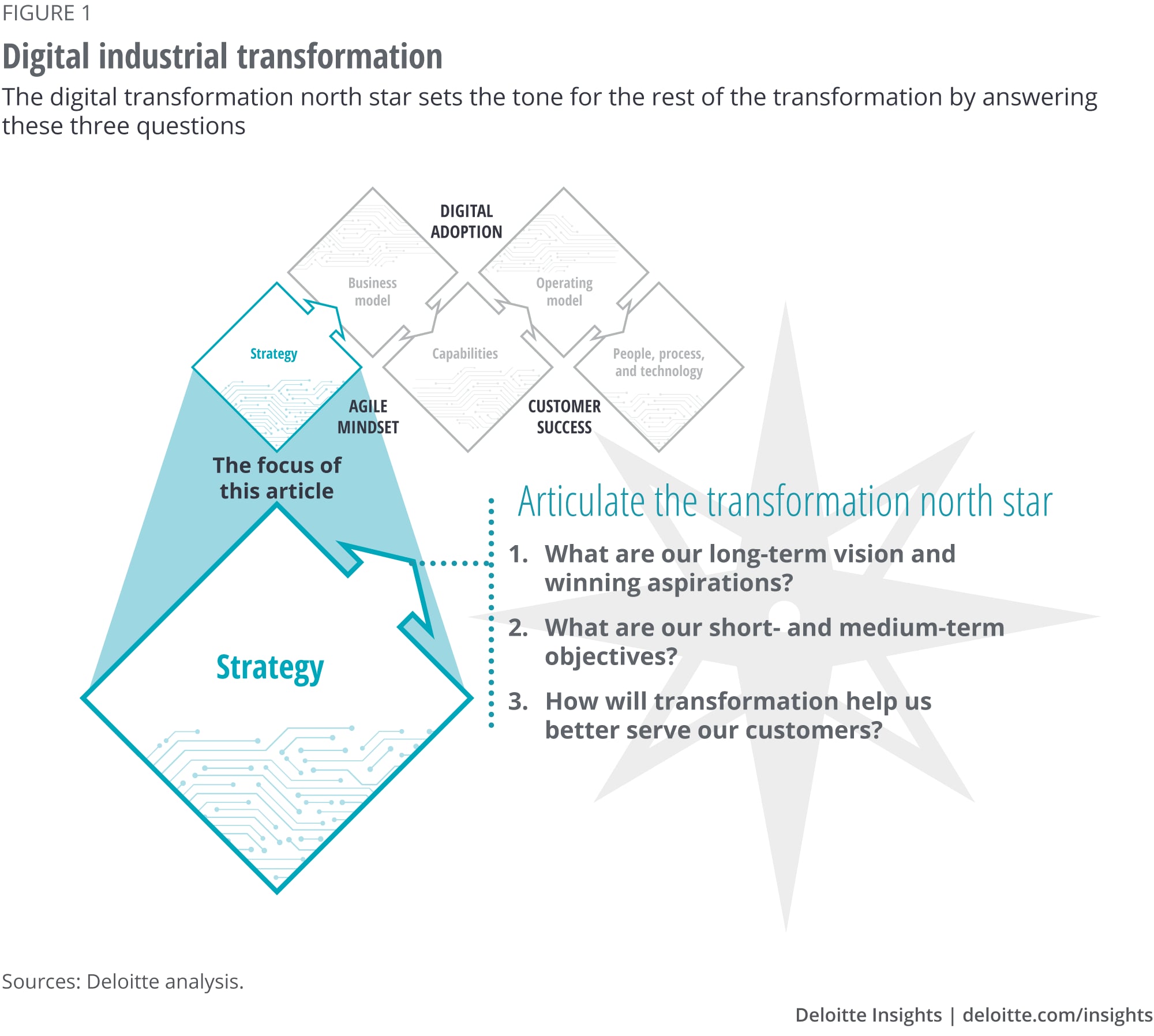
Setting the north star Staying focused and on track
6 minute read
03 July 2019
The path to Industry 4.0 often requires multiyear transformation journeys. This article, second in a series, guides leaders on setting a transformation north star that helps their organizations stay focused and on track.
In our first article of this series, Digital industrial transformation: Reinventing to win in Industry 4.0, we outlined digital industrial transformation as a path for companies to harness the power of Industry 4.0, creating and monetizing IIoT solutions by embedding new digital technologies and capabilities in their legacy assets.1 However necessary digital industrial transformation may be on an organization’s path to the fully connected industrial Internet of Things, many view the transition as complex and challenging. Deloitte’s Industry 4.0 readiness report found that only 14 percent of the 1,600 C-level executives surveyed are confident that their organizations are ready to fully harness the changes associated with Industry 4.0.2
Learn more
Explore the Digital industrial transformation collection
Explore the Industry 4.0 collection
Subscribe to receive related content from Deloitte Insights
Download the Deloitte Insights and Dow Jones app
The prospect can be daunting, and staying on track demands focus—in other words, a digital transformation north star. In this article, we will outline how to define your digital industrial transformation’s north star, the first step to helping keep your transformation not just on course but charging full speed ahead.
The digital transformation north star helps leaders keep in sight the end goal throughout the inevitable upheavals. However formulated and communicated to stakeholders, it serves a variety of purposes:
Clarity. A simply articulated message ensures that all stakeholders clearly understand the aspiration, intended outcomes, and rationale for the transformation. Clarity is perhaps the most important purpose fulfilled by the north star, considering that a third of executives report “lack of leadership vision” as a top-three challenge to establishing an Industry 4.0 strategy.3 Furthermore, the north star sets the company’s strategy for the rest of the transformation (see figure 1).
Mobilization. Digital transformation means different things to different people. Even employees directly involved in transformation initiatives may have a difficult time articulating what has changed and what’s in it for me. The north star aims to clarify employees’ purpose and keep them motivated and engaged.
Alignment. In a recent survey, a third of executives surveyed cited lack of internal alignment as a top-three challenge in pursuing digital transformation.4 The north star clearly outlines the entire company’s transformation goals, allowing each function and business unit to begin to cascade those goals and tailor its charter accordingly.
Branding. Walking the talk signals to your customers and your partners that you are a worthy digital industrial player. A well-articulated north star assures your customers that they can future-proof their most strategic initiatives with you as a strategic thought partner to help them navigate potential future market shifts.

Articulating the digital transformation north star should be the first step on any company’s digital transformation journey. It aligns leaders to a future vision that guides and shapes transformational programs, as well as a company’s decisions around how to adapt its business model, capabilities, and operating model.
Articulating the transformation north star
As our previous article established, digital industrial transformation is not only a path to growth for many technology and industrial companies—it is an imperative for survival. But just because transformation is essential doesn’t mean it will resonate with your employees, customers, partners, and shareholders. That’s why a clearly stated goal is critical.
Your transformation north star is a pithy and compelling statement that articulates:
- The transformation’s long-term (five-to-10-year) vision;
- Short to medium-term (one-to-three-year) objectives, in service of that long-term goal; and
- What it means for your customers.
Long-term vision
It is important to articulate the transformation’s long-term vision and aspiration so that those taking part in it have some idea of the destination. Companies often devote too little time and effort to crystallizing the vision. Even when they do, they frequently settle for what’s incremental rather than what’s game-changing. Deloitte’s Industry 4.0 research reveals that many organizations’ plans for digital transformation mirror current objectives, simply due to inertia.5 Regardless of whether your company seeks to retool internal operations or capture growth in the IIoT market, the long-term vision should be bold.
For instance, a mining company established a new digital center of excellence to enable data-driven planning and decision-making, and ultimately improve operational efficiency. The charter for the group was built on a broad digital vision that spanned across the entire value chain, from suppliers to customers, from equipment automation to a mobile-connected workforce. For every initiative, the new digital center of excellence used a think big, start small, scale fast approach to strike the right balance between looking far into the future and focusing on near-term momentum.6
Even companies that begin digital transformation efforts to retool internal operations may want to challenge themselves to think about capturing growth opportunity when the time is right. In fact, high ROI from digital transformation is almost as likely to result from investments in innovation as from investments in productivity.7 To unlock these growth-oriented digital transformation opportunities, companies may consider viewing their internally focused transformation as a stepping-stone to future growth.
One automotive manufacturer’s proactive insights initiative showcases this progression. Executives wanted to reduce quality issues through tele-diagnostics and predictive analytics and implemented an IoT solution that is expected to save US$8 million in warranty costs during the first 24 months—and even more in recall costs. However, they realized that sizable growth opportunity lay just one step further, in launching a fleet of connected trucks and other new services. They announced their digital transformation aspirations broadly, including their vision for a connected fleet, and earned themselves a head start in capturing a piece of the fast-growing fleet management solutions market.8
Interim mile markers
While the long-term aspirations describe the destination, it is also important to denote mile markers along the way—that’s where the short- and medium-term objectives come in. They should be concrete and measurable, to allow for quantification of early momentum and to indicate a need for adjustments where necessary.
Hitachi Vantara, a US$4 billion subsidiary of the Japanese conglomerate, pursued a medium-term objective of balancing revenues from its existing business as well as those from newer digital and as-a-service products and services, in service of its longer-term vision of driving the entire corporation’s digital transformation. Scott Kelly, Hitachi Vantara’s chief operating and transformation officer, explains: “Balancing both current revenue streams and developing new digital revenue streams was critical to maintaining the existing relationships with customers and partners, as much as it was to develop new ones. It ensured that we built a healthy foundation for future growth as we scale our digital business.”9
Customer-centricity
Finally, companies must articulate how the transformation will affect customers. After all, addressing evolving customer expectations—preferences for outcomes and solutions instead of products, opex payment models versus capex ones, etc.—may be at the heart of a company’s imperative for change. Explicitly linking the transformation and customer-centricity can make it real for employees and stakeholders internally and partners and customers externally. Hitachi Vantara, for example, conducted extensive customer mapping to discover critical engagement points, and developed an internal playbook for every department, including finance and accounts payable, to become customer-centric.10
Starting your transformation journey
Now that you’ve defined the digital transformation north star, it’s time to align your stakeholders and your organization and get them onboard. Here are a few suggestions on how to start the process.
First, amplify the north star. Signal your strategic intent to competitors, partners, customers, and employees. This requires undisputed buy-in from the C-suite beyond the CIO or CTO, often accompanied by significant investment in marketing and change management initiatives.
At one food packaging manufacturer and distributor, the CFO sponsored the digital transformation initiative, with the CIO being a visible supporter on the steering committee. This cross-functional alliance elevated the transformation from a functional program to a companywide priority.
Second, commit to the transformation. Make the transformation aspiration concrete by translating it to a financial plan. Transformation will certainly require investment but should yield superior financial performance. It is critical for leaders to understand, however, that the execution-to-value time horizon of transformations can be four to five years end-to-end. The financial plan sets appropriate expectations with your shareholders, customers, partners, and employees, and brings discipline by turning a microscope on existing investments and activities, thereby helping to minimize distractions and paving a smoother path forward.
Finally, structure and initiate. Define and launch your transformation teams and initiatives. There is an art and a science to determining the transformation’s organizational construct. It could be launched as a separate, cross-functional team, aligned to a specific line of business or embedded within existing teams. Design the team structures with intention to drive the desired outcomes.
Digital transformation presents tremendous opportunities for companies to not only revolutionize internal ways of working but also expand the horizon on growth opportunities in new markets and with new customers. Deciding where to start may be the hardest part, but that is perhaps because many organizations forgo the effort required to crystalize their north star, a critical first step to instilling focus, driving alignment, and ensuring momentum across the organization. After all, one can determine the best place to start only when one has a clear destination in mind.
Explore more of the Industry 4.0
-
Digital industrial transformation Article5 years ago
-
Industry 4.0 Collection
-
When the Internet of Things meets the digital supply network Article6 years ago
-
Industry 4.0: At the intersection of readiness and responsibility Article5 years ago
-
The Industry 4.0 paradox Collection6 years ago
-
Building Industry 4.0 capabilities through collaborations and startups Article6 years ago













